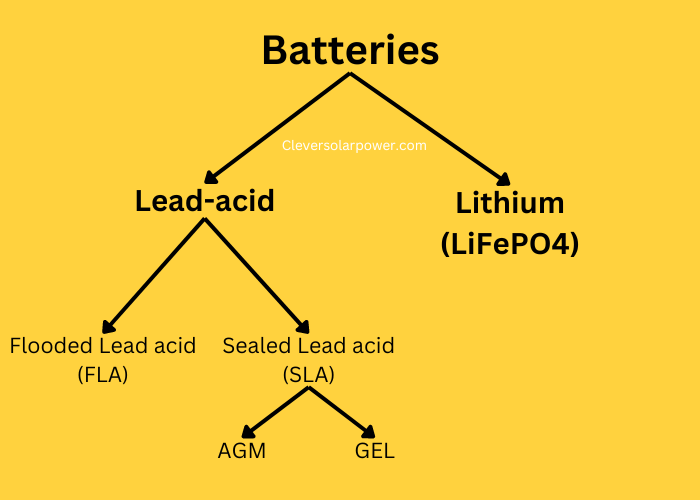Using lead-acid for energy storage for solar power is a great and cost-effective way of storing solar energy. In this article, I will show you the different States of charge of 12-volt, 24-volt, and 48-volt batteries.
We have two types of deep cycle Lead Acid batteries. These are:
- Flooded lead acid batteries
- Sealed lead acid batteries
The sealed lead-acid battery can be divided in other groups:
- GEL battery
- AGM battery (absorbent glass mat)

Here are the state of charge charts for GEL, AGM, and Flooded lead acid battery banks:
GEL Battery Voltage Chart
| State of Charge | 12V | 24V | 48V |
|---|---|---|---|
| 100% | 12.85V | 25.70V | 51.40V |
| 90% | 12.70V | 25.40V | 50.80V |
| 80% | 12.55V | 25.10V | 50.20V |
| 70% | 12.40V | 24.80V | 49.60V |
| 60% | 12.25V | 24.50V | 49.00V |
| 50% | 12.10V | 24.20V | 48.40V |
| 40% | 11.95V | 23.90V | 47.80V |
| 30% | 11.80V | 23.60V | 47.20V |
| 20% | 11.65V | 23.30V | 46.60V |
| 10% | 11.50V | 23.00V | 46.00V |
| 0% | 11.35V | 22.70V | 45.40V |
| GEL | |
|---|---|
| Bulk | 14,1-14,4 |
| Absorption | 14,1-14,4V |
| Float | 13,5-13,8V |
| Storage | 13,2-13,5V |
| Equalization | check manufacturer recommendations |
12V AGM Battery Voltage Chart
| Battery Voltage | State of Charge (%) |
|---|---|
| 12.90V | 100% |
| 12.75V | 90% |
| 12.60V | 80% |
| 12.45V | 70% |
| 12.30V | 60% |
| 12.15V | 50% |
| 12.00V | 40% |
| 11.85V | 30% |
| 11.70V | 20% |
| 11.55V | 10% |
| 11.40V | 0% |
| AGM | |
|---|---|
| Bulk | 14,2-14,6 |
| Absorption | 14,2-14,6V |
| Float | 13,5-13,8V |
| Storage | 13,2-13,5V |
| Equalization | check manufacturer recommendations |
12V Flooded Battery Voltage Chart
| Battery Voltage | State of Charge (%) |
|---|---|
| 12.70V | 100% |
| 12.55V | 90% |
| 12.40V | 80% |
| 12.25V | 70% |
| 12.10V | 60% |
| 11.95V | 50% |
| 11.80V | 40% |
| 11.65V | 30% |
| 11.50V | 20% |
| 11.35V | 10% |
| 11.20V | 0% |
How to check the voltage of a battery?
Let the battery rest for at least 30 minutes for the voltage to settle at room temperature.
After 30 minutes, use a voltage meter and set it to Voltage DC and measure between the positive and negative.
Now you will measure the resting battery voltage. Use the tables provided to estimate the state of charge of your battery.
What is the Specific Gravity of a Battery and How Can It Be Used to Measure the State of Charge?
A: The specific gravity of a battery refers to the density of the electrolyte solution (usually sulfuric acid and water) compared to the density of pure water. It is a crucial parameter in these batteries, providing valuable insights into the state of charge of the battery.
How It Works:
- Measuring Specific Gravity: You can measure the specific gravity using a hydrometer, a device that floats in the electrolyte solution. The higher the specific gravity, the more sulfuric acid is in the solution, indicating a higher state of charge.
- State of Charge Indication: A fully charged battery typically has a specific gravity around 1.265 to 1.285 at 77°F (25°C). A reading lower than this range indicates a lower state of charge. For example, a specific gravity of 1.200 might indicate that the battery is about 50% charged.
- Temperature Factor: It’s important to note that temperature affects specific gravity readings. Most hydrometers are calibrated for 77°F (25°C), so adjustments may be needed for accurate readings at other temperatures.
Why It’s Useful:
- Health Check: Regularly checking the specific gravity can help you understand the health and charging status of your battery, ensuring it’s operating efficiently.
- Early Warning: It can also provide an early warning for potential issues, such as overcharging or sulfation, allowing for timely maintenance.
Note: This method is primarily applicable to lead-acid batteries with accessible cells and is not suitable for sealed or maintenance-free batteries.
FAQ
What voltage should a AGM battery be?
It should be between 12.9V and 12.15V. If the voltage is lower, then the battery will degrade faster. Try to keep the battery above 50% State of charge (SOC) to maximize lifespan.
What is the charging voltage for a 12 volt AGM battery?
The charging voltage for a 12Volt AGM battery is 14.2V to 14.6V. If you have a temperature lower than 77°F or 20°C, use 14.6V; if the temperature is higher, use 14.2V.
What voltage is too low for a 12 volt AGM battery?
Any voltage under 12.15V is considered too low. This is 50% of the battery capacity. If you go lower than 12.15V you will reduce the lifespan of the battery. You can still go lower to 11.4V, but then the battery will have 0% capacity left. If done repeatedly, the battery will only have a few hundred cycles.
What voltage should a gel battery be?
A GEL battery should read from 12.1V to 12.85Volts. If the value is under 12.1V, the battery is depleted. Long-time depletion of the battery results in a reduced lifespan. Make sure to wait at least 30 minutes before measuring the voltage of the battery. There should be no loads attached.
At what voltage is a 12v gel battery fully charged?
If a gel battery reaches an open circuit voltage of 12.85 volts, then the battery is completely charged. However, you apply a higher voltage to charge the battery. The charging voltage of a GEL battery should be from 14.1 to 14.4Volts depending on the manufacturer. Use 14.1 to stay on the safe side.
What is the voltage of a 12V flooded battery?
A flooded lead acid battery should be between 11.95V and 12.7V. If the voltage is lower, then the capacity is below 50%. If the capacity is below 50%, then the battery will have a reduced lifespan. It is recommended not fully to discharge a lead-acid battery.
What is the full voltage of a flooded battery?
The full voltage reading of a flooded lead acid battery should read 12.7 Volts.
What voltage to charge a 48V flooded battery?
The open circuit voltage of a 48V flooded battery is 50.8V. The charging voltage is 54V.
What voltages should a lithium battery be at?
Check out my article about lithium battery voltage charts.
[custom-related-posts title=”Related Posts” none_text=”None found” order_by=”title” order=”ASC”]Sources:

I’m an off-grid enthusiast. I created this website to give clear and straight-to-the-point advice about solar power. I’m also the author of the book ‘Off-grid solar power simplified‘. Read more about me on my about page, check out my Youtube channel, or send me a message.
thank you for your helpful support and assistance with my best regards
I appreciate your post. It was very helpful to me.